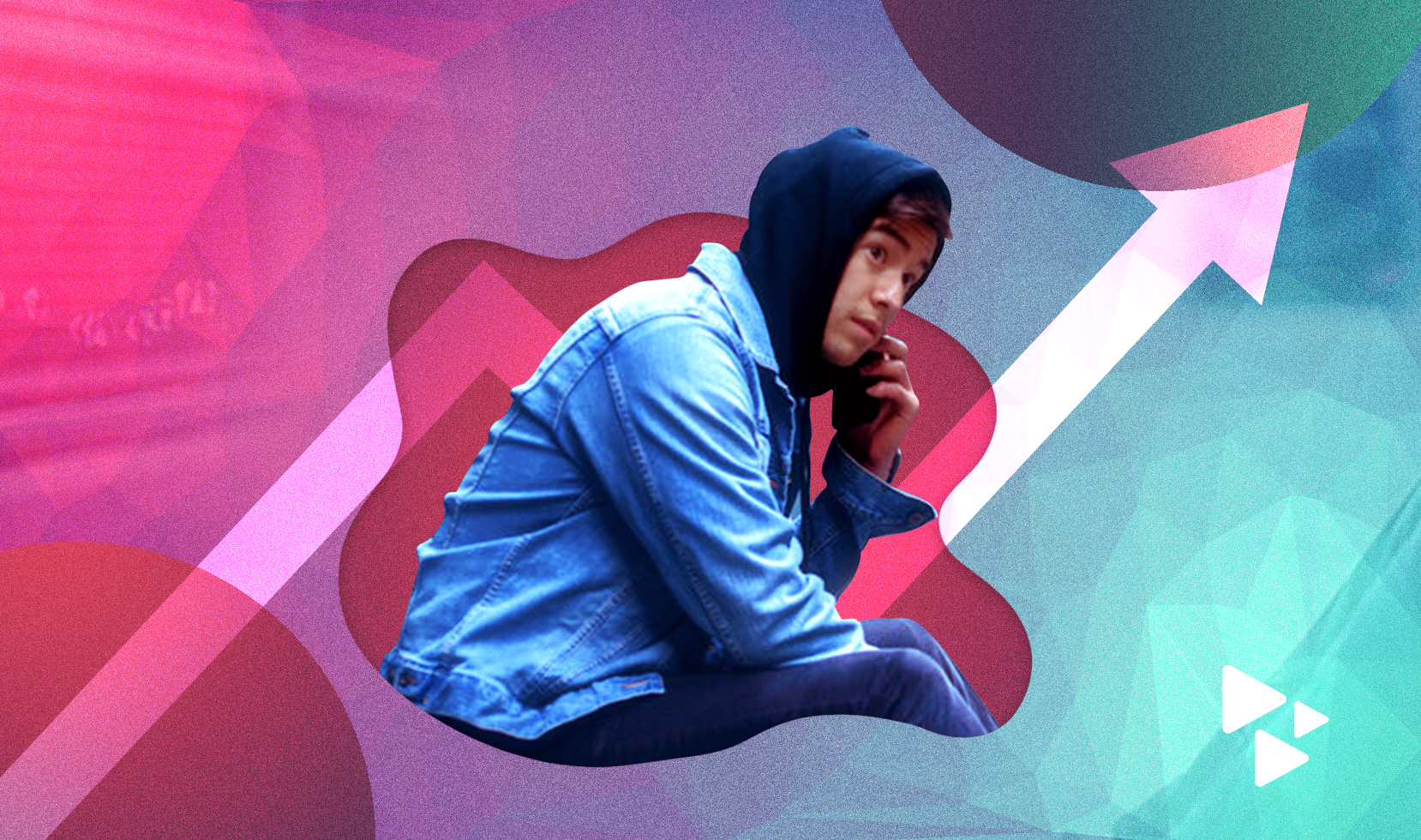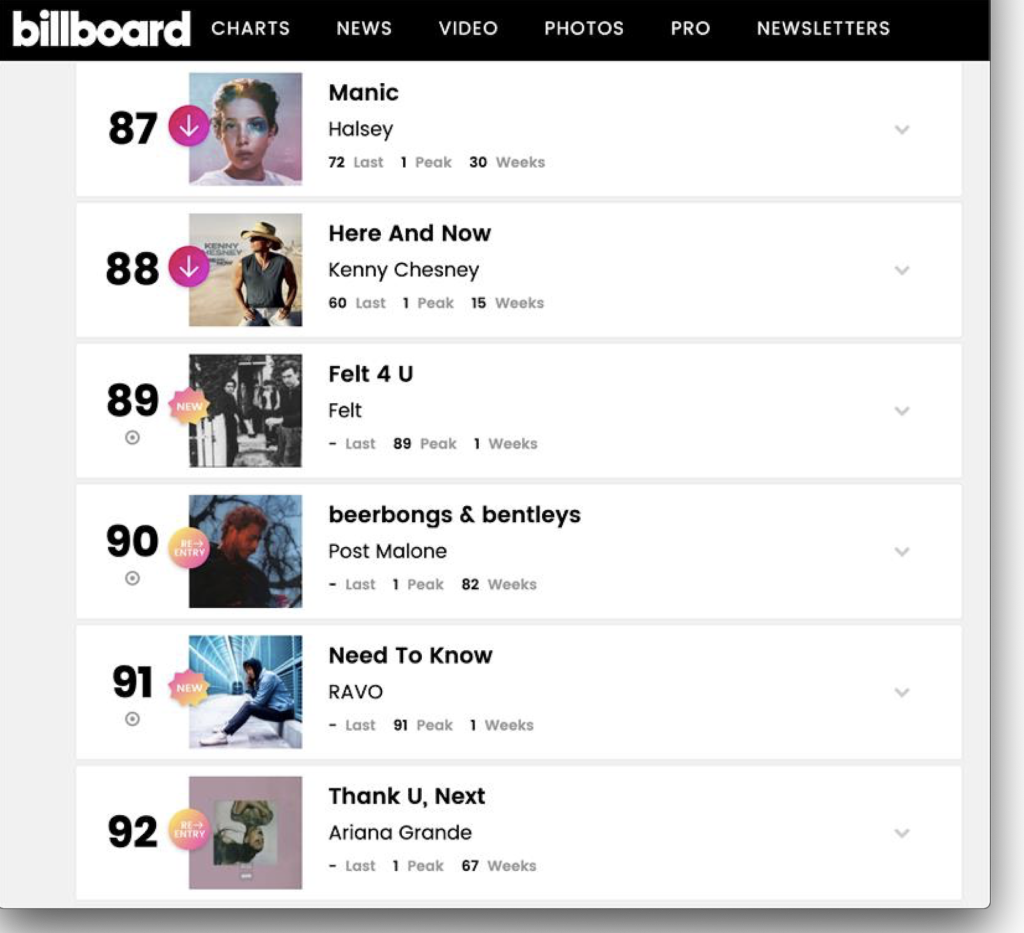
1,052 pure album sales– it sounds pretty straightforward, but it’s not. Let me explain.
Hi, my name is Eric Bravo and I make music under the pseudonym RAVO under my entertainment company, Bravo Bros. Studio. I’ve been making music since I was fourteen, but I took a slight detour in my career where I developed a cartoon short with Nickelodeon while simultaneously working on Google’s Self-Driving Car project. With time being spent indoors during quarantine, I happened upon a lot of free time this year.
Confined to my room one Saturday night, my music journey began once again as I decided to open Logic Pro X on my laptop. Little did I know I was about to embark on a life-long goal of mine: to release an album. After a ton of researching, planning, and selling, my debut album, Need To Know, charted on the Billboard Top Current Album Sales Chart at #91. It landed right between Post Malone and Ariana Grande. Now, let me explain how I did it.


The Inspiration To Chart
I happened to come across CD Baby’s blog during the early stages of my album where I found the inspiration to chart from Tyke T, Shannon Curtis and Call Me Ace. All three independent artists wrote articles piggy-backing on one another, explaining how it’s possible to get on a Billboard chart without a major record label. These articles gave me the inspiration to chart and were great guidelines and a point of reference for me on my Billboard journey. I hope my story will contribute to the Billboard series here on DIY Musician and will serve as an updated guide to independent artists looking to chart on Billboard.
Understanding the Rules
According to Tyke T and Shannon Curtis’ articles, I knew I had to reach around 750 album sales in the first week for a chance to land on the Billboard’s Heatseekers Chart. Taking into account when the articles were written and the ever-changing Billboard rules, I decided to set my first week sales goal a little higher to 1,000 albums.
There’s honestly not a lot of information online about the current rules for Billboard and what is out there contains dated information. As of August 2020, these are the rules that helped me chart on Billboard.
Rules & Guidelines
Here are some helpful rules and guidelines regarding Billboard:
- Fans are allowed to purchase up to 4 copies of your album per credit card. This can speed the process of hitting your first week goal by 4x if you have a loyal fan base.
- All pre-order sales will count in addition to your first week sales. This is important because whatever is sold in the pre-order period, will count as if they were sold your first week.
- You can have up to a 6 month pre-order period.
- Released singles count towards your album sales.
- You must get a UPC and register your album to Nielsen.
- Register each released single’s ISRC code to Nielsen as well.
- The lowest price your album can be is $3.49.
- Your album or EP must have at least 4 songs to be considered.
- In order to qualify for a specific genre, half of the album has to be that genre.
- Billboard count sales from Friday-Thursday, so try to release on a Friday.
- Billboard refreshes the charts every Tuesday the week after your album is released.
- As of September 2020, bundling merch has been discontinued.
- As of January 2020 most of the Billboard charts are now consumption based charts.
Consumption Based Chart vs Pure Album Sales Chart
As of January 2020, Billboard switched most of their charts from a pure album sales chart to a consumption based chart.
A pure album sale chart includes album sales only (no streams considered). Album sales are categorized as albums purchased digitally or physically.
A consumption based chart includes album sales and two other metrics; streams (video or audio) and track sales.
Most of the information out there regarding charting on Billboard explains how artists should aim for the Heatseeker chart since you’ll only need about 750 album sales the first week to chart. However, this is not true anymore. They were referring to this chart as an album sales chart but as of January 2020, it is now a consumption based chart. This new rule makes it harder for indie artists to chart on the Heatseeker chart without the help of a record label, a placement on a Spotify editorial playlist, or a viral success of a song.
Picking a Chart To Aim For
By going through this experience, I would not recommend aiming for the Heatseeker chart as an independent artist. To chart on Heatseeker now, your first week streams have to be massive and without a big fan base, this is difficult to accomplish.
If you still do want to pursue a pure album sale chart, there are two Billboard charts you can aim for:
- Top Current Album Sales (the one I charted on) – include new albums that are less than 18 months old. There are 100 spots.
- Current Album Sales Chart – includes new and category albums. An album is considered in a “category” when an album has been out for more than 18 months. In this chart, you are competing with classic albums, such as, Kendrick Lamar’s good kid, m.A.A.d city. There are 100 spots.
From my understanding, album sale charts will eventually be phased out. I barely made the Top Current Album Sales chart selling 1,000 albums first week. If you’d like to make a dent in either of the aforementioned charts, you’ll have to sell at least 1,100-1,500 pure album sales first week. With this first week sales number, you are aiming to place on towards the lower mid chart. Your chances of landing on the top of these charts are slim since you are competing with popular artists.
How I Charted on Billboard
Now that you understand how the rules are played and how often they change, here’s how I managed to land on the Billboard “Top Current Album Sales” chart.
Pre-Orders
Pre-orders play a huge role when it comes to securing a spot on a Billboard chart. Billboard allows all the pre-order sales you make before your album release to count in addition to your first week sales. You can have up to a 6 months pre-order period. This means, within this 6 month period (if you choose to sell for that long), all of the sales you make will count towards your first week sales as well. I was a bit too impatient to wait 6 months, so I decided to give myself a 6 week pre-order period.
Picking a Platform
It really came down to two platforms: iTunes and Bandcamp.
This was a hard decision to make. I wanted to choose iTunes in hopes of also securing a spot on the iTunes Chart as well, but it was too risky if my ultimate goal was to chart on Billboard. I decided to go with Bandcamp because of the following reasons:
- Less clicks to pre-order. When I tried to pre-order my own album on iTunes, it instead took me to Apple Music. Apple is making it harder for customers to buy and find music on iTunes and I did not want to lose any potential sales with this misdirection.
- Live Sale Updates. One great feature Bandcamp has that iTunes doesn’t is its live sales updates. I can see a true count of how many pre-orders have been sold and who pre-ordered my album instantly. There’s no way of tracking pre-orders on iTunes. You’re essentially going in blind.
- Easy To Price. Bandcamp allows you to have full control of your album’s price on their dashboard. You can change the price without any delays. I learned the lowest I could price my album is at $3.49, so I priced it at an even $3.50 with easy. There are too many barriers trying to change the pricing on iTunes.
- Can continue to work on my album. I was still not done with my album when I started to sell pre-orders. With bandcamp, I was able to get the ball rolling with pre-orders while I continued to work on my album. With iTunes, there is less flexibility as you’ll have to turn in your album a few weeks before your release date. With a click of a button, Bandcamp allows you to release your project instantly.
The Execution
I decided to release Need To Know on August 7th, 2020. I gave myself 4 months to finish the album and a 6 week pre-sale period. With Bandcamp, being able to track my sales was essential. I was able to see how many pre-orders I needed left to hit my goal and I always knew exactly where I was with sales.
My plan was to release 4 singles leading up to the August release, essentially releasing a single a month to give my fans something as they wait for Need To Know to drop. With the singles, my Spotify listeners reached 34K monthly listeners and my singles racked up a total of 80K streams on Spotify and Apple Music. If you still want to aim for the Heatseeker chart, just note that you’ll need more than 80K streams and 1,000 pure album sales in the first week.
The Results
The weekend before I was going to find out if I charted or not, a Billboard representative reached out to me via email saying that Need To Know was flagged to possibly land on the following charts: Hip-Hop/R&B, Rap, Heatseeker, and the Independent chart.
I was ecstatic. The representative had me send a copy of my album, the cover art and an artist photo for their records. I had a good feeling that I was going to make it.
Tuesday comes only to find out that my album charted on a completely different chart entirely. Need To Know charted #91 on the “Top Current Album Sales” chart. This chart wasn’t even “flagged” by the representative who reached out to me. I was happy that my album charted on Billboard, but was confused as to why it charted on a chart that was not even flagged. Turns out, BIllboard will flag “genre” charts and will put them into their system so they can research your consumption numbers to see if you can make it on any of the flagged genre consumption charts. This goes to show that if you do want to make it on Billboard, you should keep updated on the rules and get a clear understanding of how entering each chart works to make sure you’re playing the game right.
Essentially, if you pursue my method of securing 1,052 pure album sales in the first week, just make sure Billboard still has the “Top Current Album Sales” chart and it is still considered a pure album sales based chart. It would be devastating if you put in all this hard work only to find out Billboard doesn’t have pure album sales charts anymore. I hope my story helps you on your Billboard journey. If you do make it, congratulations and go get your Billboard plaque! I found Jewel Box Platinum and Wright’s Media to be reputable plaque sellers.
For more, check out his website www.eric-bravo.com and follow him on Instagram, Twitter, or his music Instagram.